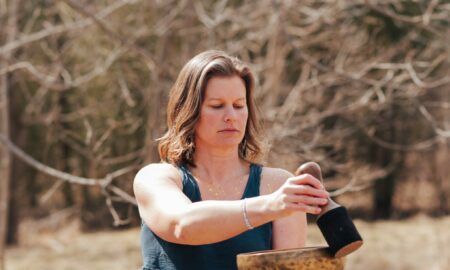

Today we’d like to introduce you to Tracy Lee Stum.
Tracy Lee, we’d love to hear your story and how you got to where you are today both personally and as an artist.
My story is about serendipity and trusting my intuition to find my truest creative path. Upon finishing my BFA in Painting and Drawing, I found myself trying on many different hats in the world of art careers: from art directing to visual merchandising, scenic painting to decorative painting and finally settling into being a mural painter. While these various practices were embarked upon with pragmatic objectives in mind, I never imagined I would find myself engaging in ‘painting’ images on sidewalks around the world! Practicality had nothing to do with my choice to pursue street painting – it centered on the excitement, joy and personal resonance I felt every time I put chalk to pavement.
I discovered street painting in 1997 at the Santa Barbara I Madonnari festival. I stumbled upon it by accident and immediately knew I had to try it out. Scores of artists were drawing astounding masterpieces in chalk pastel on the asphalt of the Mission parking lot – I was blown away by the images I saw there. In response, I signed up for the event the following year and in 1998 drew my very first street painting. It’s been a love affair ever since.
Street painting was a journey of self-discovery for me – it was the best practice to understand and explore the most authentic form of creative expression to me. I never knew I was a ‘performer’ – in fact I always shied away from the spotlight, but after continual engagement with the practice I found a love for sharing my work and process publicly.
Because I was so intrigued and engaged with the practice, I created an intention of pursuing this as a full-time career. I had no idea if it were possible but I knew I wanted to continue painting on pavement somehow. I decided to put up a street painting website after a few years and miraculously, others saw value in the work and began hiring me to draw at events, etc. 3D Street Painting exploded into public consciousness in the mid 2000’s via the internet, and I was fortunate enough to be one of the pioneers exploring expanding opportunities with the art form. As a result, my life has been a dream come true in which I am fortunate to enjoy traveling with my art, sharing with cultures and communities around the world.
We’d love to hear more about your art. What do you do you do and why and what do you hope others will take away from your work?
What:
3D street painting is an art practice involving the use of anamorphic perspective to create optical illusions that appear to be in 3d, on a 2D surface. These images are designed to be viewed from one particular viewing point, best seen through a camera lens.
How:
Anamorphic perspective technology involves distorting an image to a degree dependent on the established viewing point and the arts relation to that point. It’s a way of ‘mapping’ an image so that it appears in proper scale and orientation when viewed through the camera lens. As you move around a 3D piece of art, you notice the distortion that occurs, becoming more exaggerated as you move away from the viewing point. The traditional practice involves using chalk pastels to make the work of art, however in the last 10 years, paint has become widely used.
Why:
Because it’s pure fun! I am always still amazed when the illusion is revealed. There is something very satisfying when you can create and render an image to seem believable even though it’s merely a flat painting. I enjoy playing with ideas about perception – how reality can be altered with some imagination. I enjoy witnessing how illusions ask us to use our imagination to play.
What do you think it takes to be successful as an artist?
Great question! Success for me is when I can experience joy and a sense of well-being from my life – in this case, from making art. I love being involved in all phases of the art making process – from research to conceptualization to execution. I’m always learning something new from each piece I create so the opportunities offered for personal growth are never ending. Being appreciated, being respected and being valued for what I do also brings a sense of connection with the larger world, in that the method I choose to communicate resonates with many.
To be successful the artist must first realize that art is more than a profession, it’s a path toward truth and self-realization both for maker and viewer. Artists are here to make real the unknown, to reflect back to humanity its own kaleidoscopic nature along with the world it inhabits.
On a practical level, study with a mentor, continually learning and pushing oneself is invaluable. Ask questions, take workshops and classes from other artists you admire, hone your craft. Spend time finding grants, residencies, exhibitions and programs you can apply to – network. Take some business classes or find a business mentor to help you navigate the workings of making a living from your art. I’ve had luck with licensing my art over the years, which is another great way to provide income from your work. Perseverance is my mantra. Trust yourself and your work.
Do you have any events or exhibitions coming up? Where would one go to see more of your work? How can people support you and your artwork?
My works are typically site specific and are only viewable for a short period of time after I complete them. I’ve embraced the ephemeral quality of my work and do appreciate that these images become extra special due to their very short lifespan. At this time my website, social media accounts and YouTube offer videos and photos of projects I have completed.
That being said, I do enjoy creating more ‘permanent’ pieces and plan to make space for more of these in the future. One way to support the work is to attend local street painting festivals. These are great ways to become acquainted with the art form and support local artists.
Finally, anyone interested can pick up a copy of my book ‘The Art of Chalk’, Quarto Publishing 2016. This book focuses on street painting, chalkboard artists and pastel fine artists – it’s formatted as a ‘how to’ book so anyone with an interest can find useful tips and information on process, from over 50 international artists.
Contact Info:
- Address: 11391 Citrus Drive, #103
Ventura, CA 93004 - Website: www.tracyleestum.com
- Phone: 805.340.3907
- Email: tracy@tracyleestum.com
- Instagram: tracyleestum
- Facebook: https://www.facebook.com/3dstreetartist/
- Twitter: twitter.com/tracyleestum
- Other: instagram.com/tracyleestum






 Image Credit:
Image Credit:
Tracy Lee Stum.
Getting in touch: VoyageDallas is built on recommendations from the community; it’s how we uncover hidden gems, so if you know someone who deserves recognition please let us know here.


















